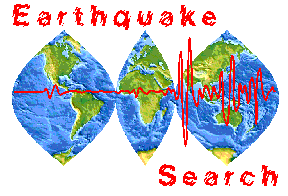
MAGNITUDES
MAGNITUDES: Magnitude, a logarithmic measure of the "size" of an earthquake, is related to the energy released as seismic waves at the focus of an earthquake. Although the magnitude scale has neither "top" nor "bottom" values, the highest magnitude known was about 9.5, the lowest about -3.0. On this logarithmic scale, a magnitude 6.0 shallow-focus earthquake represents elastic-wave energy about 30 times larger than that generated by a magnitude 5.0 earthquake, 900 times (30x30) larger than that of a magnitude 4.0 shock.
Many factors influence the determination of earthquake magnitude, including focal depth, distance between earthquake focus and observing station, frequency content of the sampled energy, and earthquake radiation pattern.
Magnitude values calculated by the USGS with a brief description of parameters are shown below (see paragraphs under Contributed Magnitudes for appropriate references):
-
Surface-wave (Ms): Magnitudes are computed for
earthquakes that are located at distances between
20 and 160 geocentric degrees from the recording
station, seismic-wave period between 18 and 22
seconds, and depth is less than 50 km (generally
Ms magnitudes are not computed for depths greater
than 50 km.
Body-wave (mb): Magnitude values are computed based on the seismic-wave period greater than or equal to 0.1 and less than or equal to 3.0, and distance is greater than or equal to 5 degrees.
Moment Magnitude (Mw): The magnitude is computed from a long-period body- and mantle-wave moment tensor inversion method; it is also related to the product of the area of the earthquake fault, multiplied by the average fault slip over that area and by the shear modulus of the fault rocks. The Mw value is approximately the same as the Ms magnitude value.
Energy Magnitude (Me): These magnitudes are computed from the radiated energy using the method described in Choy and Boatwright (1995). The energy radiated by an earthquake is estimated from the energy spectral density of the broadband P waves (Boatwright and Choy, 1986). The Me can complement moment magnitudes (Mw) in describing the size of an earthquake. Me, being derived from velocity power spectra, is a measure of the amount of damage that could be caused. Mw, being derived from low-frequency asymptote of displacement spectra, is more physically related to the final static displacement of an earthquake.
Local Magnitudes:
-
Local Magnitude (ML): This magnitude is
generally referred to as the true "Richter
magnitude" (originally defined for
California). The values are computed for
distances less than 600 km with depths less
than 70 km. These estimates are computed in
the western part of the United States as well
as world-wide, often using different calibrating
functions.
Local or Regional Magnitude (Mn or MbLg): This value is calculated for the area of North America east of the Rocky Mountains. It is computed from the vertical component 1-second Lg seismic-waves (short-period surface waves). It has also been used in other parts of the world, using different calibrating functions.
Other Magnitudes:
-
Duration Magnitudes (MD or CL): These estimates
are derived from the duration or coda length
of earthquake vibrations. Duration or coda
length magnitude scales are normally adjusted to
agree with ML or Mn estimates. The MD
formulas vary for different geographic
regions and for different seismographic
instruments.
Felt Area Magnitudes (FA or MI): The estimate is compatible with an estimated mb magnitude. It is commonly computed from the felt area for earthquakes which occurred before seismic instruments were in general use. The estimates are based on isoseismal maps or defined areas using intensity-attenuation relationships.
Unknown Magnitudes (UK): The computational method was unknown and could not be determined from published sources.
-
mb = Average NEIS body-wave magnitude.
OBS = Number of amplitudes used in the mb magnitude computation.
Ms = Average NEIS surface-wave magnitude (if given, Z = vertical component, H = horizonatal component).
OBS = Number of amplitudes used in the surface-wave magnitude computation.
CONTRIBUTED VALUES:
Any magnitude other than NEIS mb and Ms may show
in these fields, including some magnitudes computed
at NEIS.
The value may have been
calculated from one station or it may be an
average magnitude value from a number of stations
in the network. Up to two magnitudes may be given here.
The second magnitude (if given) is coded on a line
immediately beneath the first one. The
contributed magnitude field consists of 11
characters: positions 1-4 = magnitude value;
positions 5-6 = magnitude scale; and postions 7-11
= organization source; if blank,
the source is the same as the one shown under the
catalog source column.
A number of magnitude scales are defined by source agencies or institutions. The magnitude scales in the data base include:
-
UK = Unknown magnitude scale
Ms = Surface-wave magnitude; Bath, 1966
mb = Body-wave magnitude; Gutenberg and Richter, 1956
ML = Local magnitude; Richter, 1958
Mn = Nuttli magnitude; Nuttli, 1973
MD = Coda-length magnitude
FA or MI = Felt area magnitude; approximately equivalent to an mb value
mB = Broad-band, body-wave magnitude; Abe (1981, 1982, 1984), Abe and Kanamori, 1979, and Abe and Noguchi (1983a,b)
Mw = Moment magnitude, Hanks and Kanamori, 1979
Mz = Magnitude based on the cycles/second of the Sg-phase
MI = Magnitude computed from the epicentral intensity value
K = Energy class magnitude value; Kondorskaya and others, 1982.
Beginning with January, 1986, a contributed magnitude of unspecified type may be quoted (using the designator MG) for events which have no other magnitudes given or computed. These MG magnitudes either have been reported by the contributor without listing the type (such as "Mag 3.5") or have been computed using procedures which are not defined by the magnitude types routinely reported.

